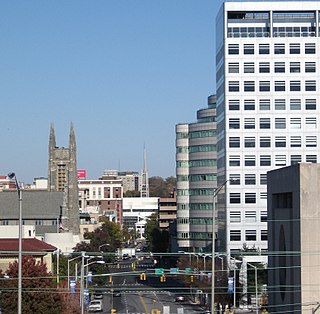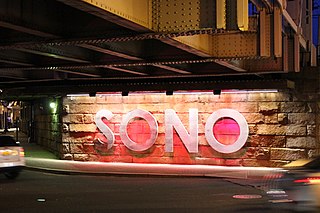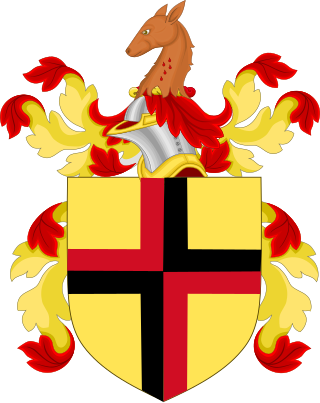Related Research Articles

Fairfield County is a county in the southwestern corner of the U.S. state of Connecticut. It is the most populous county in the state and was also its fastest-growing from 2010 to 2020. As of the 2020 census, the county's population was 957,419, representing 26.6% of Connecticut's overall population. The closest to the center of the New York metropolitan area, the county contains four of the state's top 7 largest cities—Bridgeport (1st), Stamford (2nd), Norwalk (6th), and Danbury (7th)—whose combined population of 433,368 is nearly half the county's total population.

South Norwalk is a neighborhood in Norwalk, Connecticut which corresponds to the city's Second Taxing District. Often referred to as SoNo, the neighborhood was originally settled as Old Well, then chartered as the city of South Norwalk on August 18, 1870. The cities of Norwalk and South Norwalk were incorporated on June 6, 1913. South Norwalk underwent major redevelopment during the early 21st century, with many new apartments being constructed, often in close proximity to South Norwalk station, and generally more expensive than existing housing.

Roger Ludlow (1590–1664) was an English lawyer, magistrate, military officer, and colonist. He was active in the founding of the Colony of Connecticut, and helped draft laws for it and the nearby Massachusetts Bay Colony. Under his and John Mason's direction, Boston's first fortification, later known as Castle William and then Fort Independence was built on Castle Island in Boston harbor. Frequently at odds with his peers, he eventually also founded Fairfield and Norwalk before leaving New England entirely.

The history of Norwalk, Connecticut ranges from pre-contact cultures and Native Americans to the 21st century.

Silvermine is an unincorporated community in Fairfield County, Connecticut, United States that extends across three southwestern Connecticut towns: Norwalk, New Canaan and Wilton.
The Central or Midtown section of Norwalk, Connecticut is an urbanized area in roughly the geographic center of the city, north of the South Norwalk neighborhood and the Connecticut Turnpike. Wall Street, West Avenue and Belden Avenue are the main thoroughfares. It has also been called "Norwalk Center" or "Downtown Norwalk".

Cannondale is a census-designated place (CDP) within the town of Wilton in Fairfield County, Connecticut. It had a population of 141 at the 2010 census. The neighborhood consists of many old homes on large, almost rural lots now largely wooded. The English first settled the land in the 17th century. At the center of Cannondale is Cannon Crossing, a small shopping village of boutiques and restaurants made up of 19th-century buildings restored by actress June Havoc in the late 1970s on the east side of Cannondale Railroad Station. Both are part of Cannondale Historic District, which encompasses the central part of Cannondale and most of its significant historical buildings.
Richard Olmsted was a founding settler of both Hartford and Norwalk, Connecticut. He served in the General Court of the Connecticut Colony in the sessions of May 1653, October 1654, May 1658, October 1660, May 1662, May and October 1663, May and October 1664, October 1665, May and October 1666, May 1667, May and October 1668, May 1669, May 1671, and May 1679.

Established in c. 1655, the East Norwalk Historical Cemetery is Norwalk's oldest cemetery, and many of the area's first settlers are buried there. The cemetery is owned and maintained by the Third Taxing District, formally known as the East Norwalk Fire District of the Town of Norwalk, and before that it was known as the Down Town School District. Triangle shaped and surrounded clockwise by Gregory Boulevard, Cemetery Street and East Avenue it is situated in the neighborhood of East Norwalk.
Matthew Canfield was a founding settler of Norwalk, Connecticut and Newark, New Jersey. He served as a deputy of the General Court of the Connecticut Colony representing Norwalk in the sessions of May 1654, May 1655, May 1656, May 1657, May 1658, May 1659, May 1660, May 1661, May and October 1662, October 1663, May and October 1664, May and October 1665, and May and October 1666.

Richard Webb I was a founding settler of Hartford and Norwalk, Connecticut. He served as a deputy of the General Court of the Connecticut Colony from Norwalk in the session of May 1656.
John Gregory, a cobbler and tanner, was a founding settler of Norwalk, Connecticut. He was a deputy of the General Court of the Connecticut Colony in the sessions of October 1659, October 1662, May 1663, May 1665, October 1667, May 1668, May and October 1669, October 1670, October 1671, May 1674, May 1675, October 1677, May 1679, October 1680, May 1681, October 1695.
George Abbitt (1634—1689) was a founding settler of Norwalk, Connecticut.
Stephen Beckwith was a founding settler of Norwalk, Connecticut. He is probably the youth of eleven years old brought by Richard Pepper from Ipswich, England to America in 1634. He was at Hartford in 1649, and moved to Norwalk prior to 1655. He sold his farm to Richard Homes in March 1663. He was still living in Norwalk as late as 1687.
Thomas Hanford was a founding settler of Norwalk, Connecticut. He was the first minister in Norwalk, and continued in charge of the settlement's church for forty-one years, until his death in 1693. In addition to his spiritual leadership, he also served as the civic leader and school teacher of the settlement.
Richard Holmes was a founding settler of Norwalk, Connecticut.
Thomas Lupton (1628—1684) was a founding settler of Norwalk, Connecticut. His name appears in the early records of the settlement, but little is known, and his name also disappears soon thereafter. He apparently came to Norwalk in 1655 from the New Haven Colony. He was named a freeman in 1664.
Ralph Keeler was a founding settler of both Hartford, and Norwalk, Connecticut, United States.
Jonathan Marsh (1621–1672) was a founding settler of the New Haven Colony, and of Norwalk, Connecticut. He came to Norwalk from New Haven sometime prior to March 1656. He was the settlement's miller.
